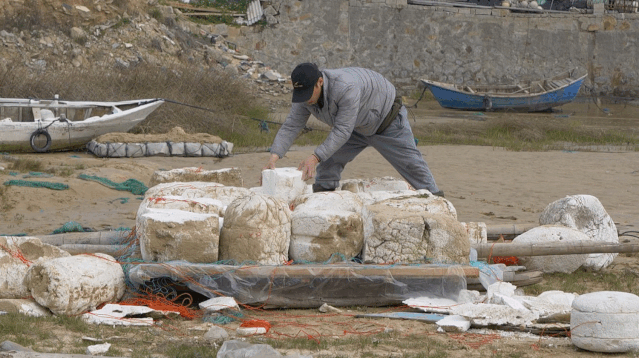
Editor’s note: On May 20th, CAFA Online Graduation Season was officially launched. Within the first 24 hours, online browsing exceeded 2.13 million, and the number of individual visitors reached 530,000. Up to now, online browsing has exceeded 2.46 million with 620,000 independent visitors from 115 countries around the world. This graduation exhibition has attracted global participation and attention.
Offline exhibitions can collect feedback from the audience as soon as they visit, and they can accurately receive information from the art market and then become a stage for exchange and learning between students ... In comparison, we know very little about the online graduation exhibition. How do teachers from CAFA look at this new form of graduation exhibition? How do they guide students to create? What challenges did they encounter? CAFA ART INFO interviewed Associate Professor Mu Boyan from the Sculpture Department, School of Fine Arts, CAFA. He discussed his opinion and comprehension of topics such as the graduation creation courses, students’ creations and the online exhibition in the Sculpture Department.
Interviewee丨Mu Boyan (Associate Professor for Sculpture Department, School of Fine Arts, CAFA)
Interviewer | Yang Zhonghui/CAFA ART INFO
Interview time丨April 28, 2020
Photo courtesy of Mu Boyan
Translated and edited by Sue/CAFA ART INFO
CAFA ART INFO: Hello Prof. Mu, for the pandemic situation, CAFA Graduation Exhibition has undergone a lot of changes this year. We have therefore paid attention to the topics related to the students’ graduation creations. Can you talk about the graduation creation course of the Sculpture Department for us first?
Mu Boyan: The Graduation Creation Course of the Sculpture Department is an extension of the sculptural practice over the past five years and it is a continuous process of experimentation and accumulation. It covers the essence of many required courses from model training, material practice, training in thinking, social practice and proposition creation. The teaching system of the six studios in the Sculpture Department have different academic directions, this cuts into the study in sculpture from different methods and perspectives. While mastering the professional skills of sculpture, students gradually become clear about the directions of their artistic pursuits. Just like climbing Mount Everest, everyone started climbing from different places, after experiencing various tests and experiences, they moved closer to a common goal. This final peak is the current graduation creation.
The Graduation Creation Course of the Sculpture Department before the pandemic was in full swing and the students had already stepped up and spread their stalls according to their creative needs. There were “base areas” for graduates in various studios or corners at the teaching building of the Sculpture Department. Although they were scattered but they created in an orderly fashion. The Graduation Creation Course is actually a big cycle. In this cycle, students have great freedom and there is a lot of room for them to play with. The follow-up guidance of each tutor is also random and irregular. Although the classroom did not seem to be organized, the teaching and learning in the creative class was very organic. When the situation changed sharply, the normal teaching activities had encountered a big gap. The pandemic disrupted this organic model of the creative course, forcing the “l(fā)abor-style” teaching mechanism of the Sculpture Department to temporarily stagnate. It worked like a frozen computer which needed to be restarted.
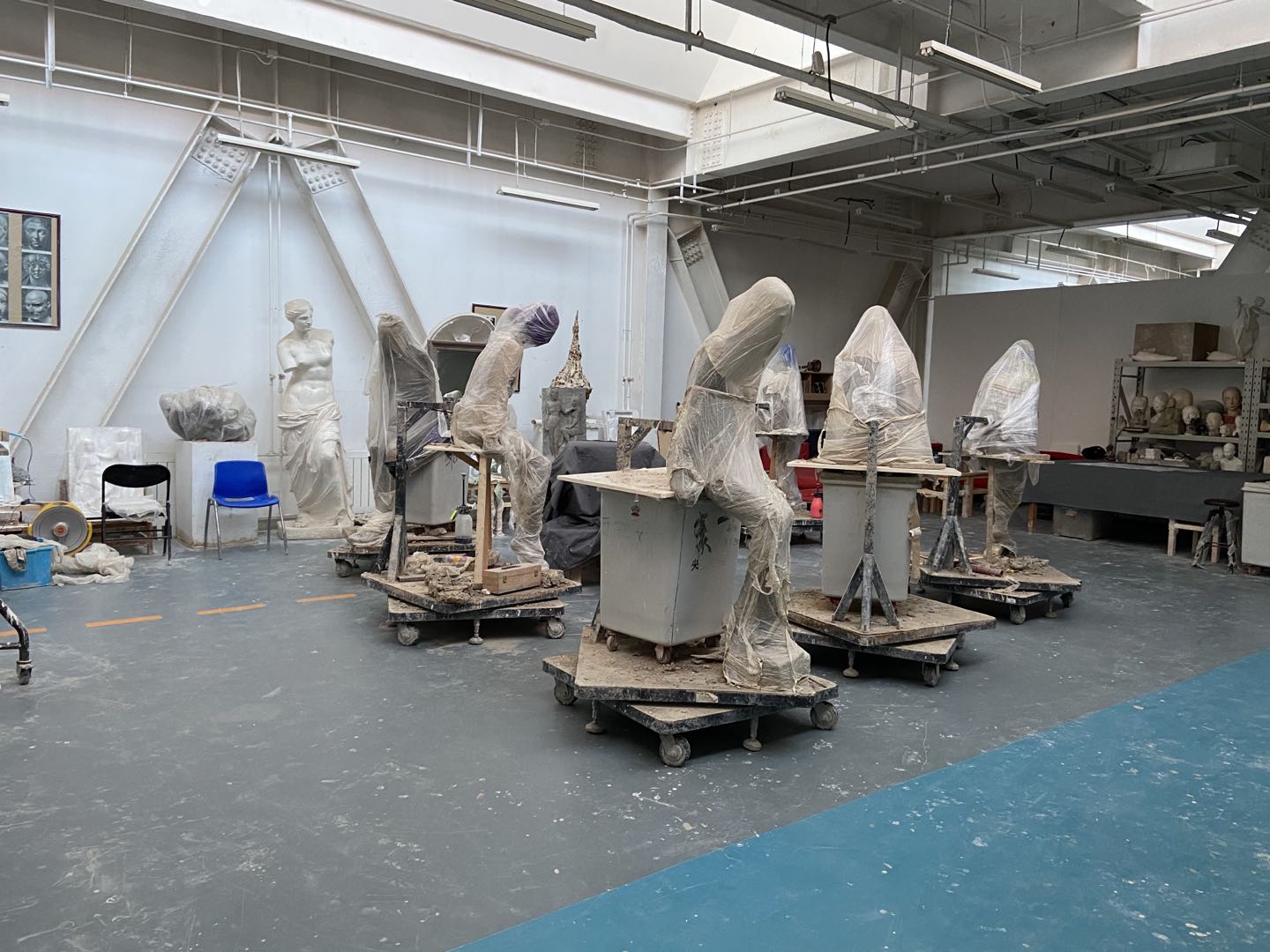
After the closure of CAFA, there were no one but sculptures left in the Sculpture Department.
When this happened, everyone needed to start their own adaptation and transformation capabilities. Some classmates had to create conditions from none, and insisted on completing the productions according to their plans; some classmates used local materials, used whatever they had and tried a new material language; some classmates reflected on themselves in the realistic situation and recorded the reality in transition; although some students were “exiled”, they discovered the “new continent” ... these students created new starting points for their creations in their respective coordinates. Although everyone had lost their generous creative conditions, they have gained some long-lost freshness. For the creation, sometimes “encounter” is more valuable than “familiarity”. This is absolutely an opportunity.
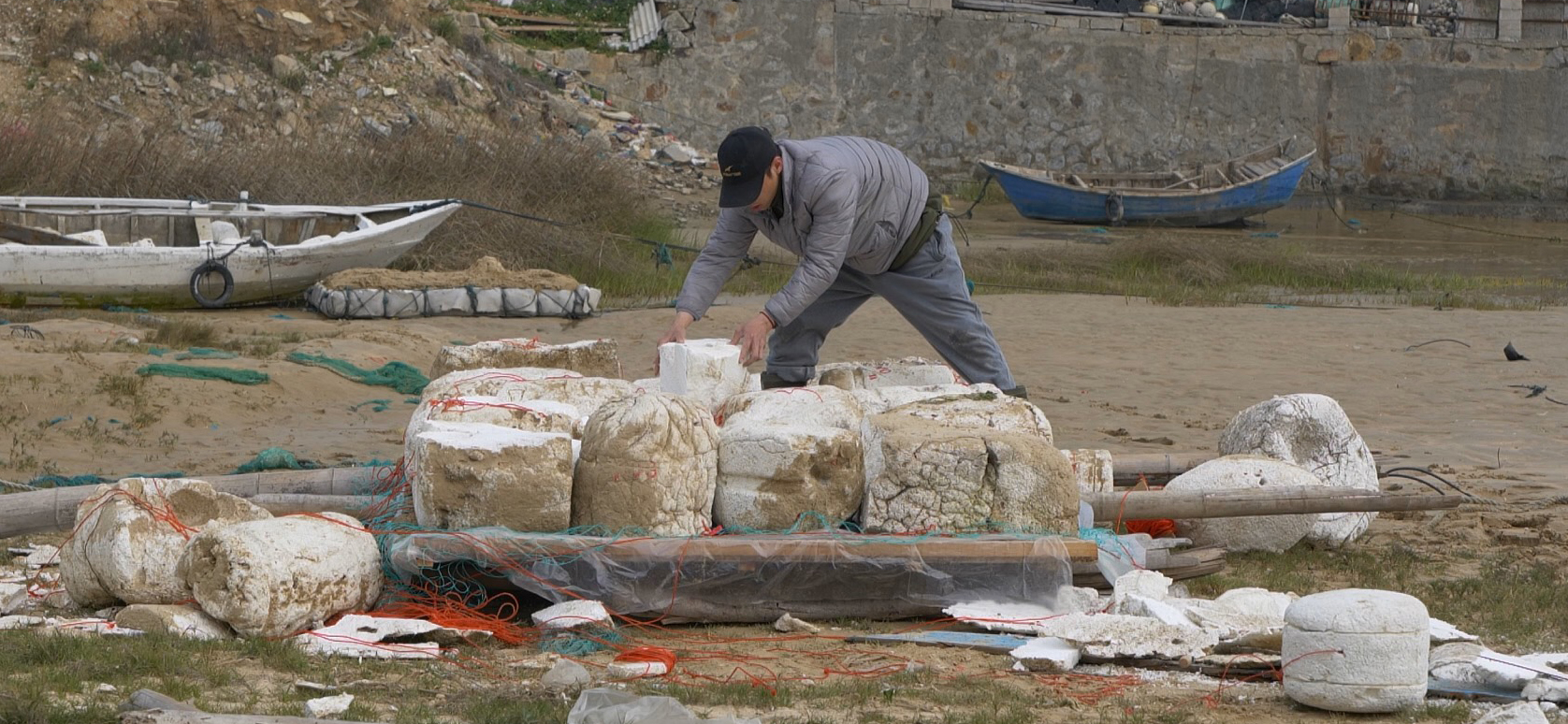 Zhao Xiu, Postgraduate Student of 2017 Session
Zhao Xiu, Postgraduate Student of 2017 Session
Tutor: Sun Wei, Coordinate: Pingtan, Fujian Province
Zhao Xiu created in an open-air environment. His work mainly uses floating objects on the beach as an entry point, that is, by picking up floating objects on the beach and combining them with sand to make a temporary space. He will use this space to return to the sea again and use the practice of drifting to respond to the uneasiness caused by drifting things.
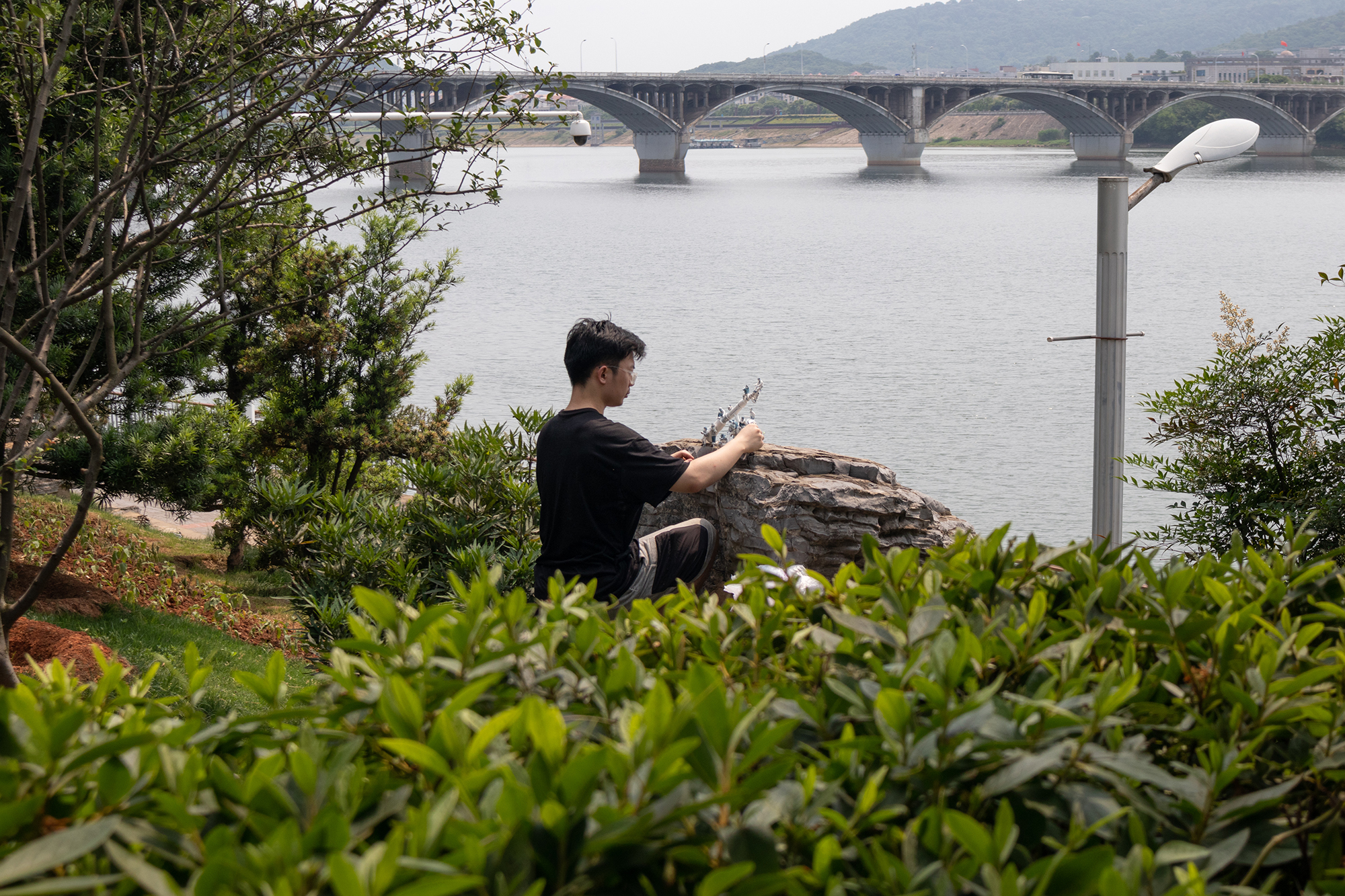
Xu Zebang, Undergraduate of 2015 Session,
the Sixth Studio of Sculpture Department, Coordinate: Changsha, Hunan Province
The artist devoted his emotions on his hometown of Changsha to mountains, noodle bowls, notebooks, chessboards and fishing rods, from which we can find the wonderful life of people.
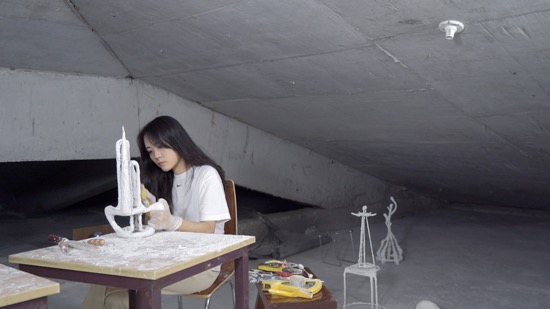
Li Yu, Undergraduate of 2015 Session,
the First Studio of Sculpture Department, Coordinate: Jinan, Shandong Province
Li Yu was working in her own rough attic. The space had a sense of mystery. Her work was very similar to witchcraft, but it was also like a totem with a soul. The space has a great influence on her work. It changed the temperament of the work. The most important thing was that it forced her to think about the relationship between sculpture and space.
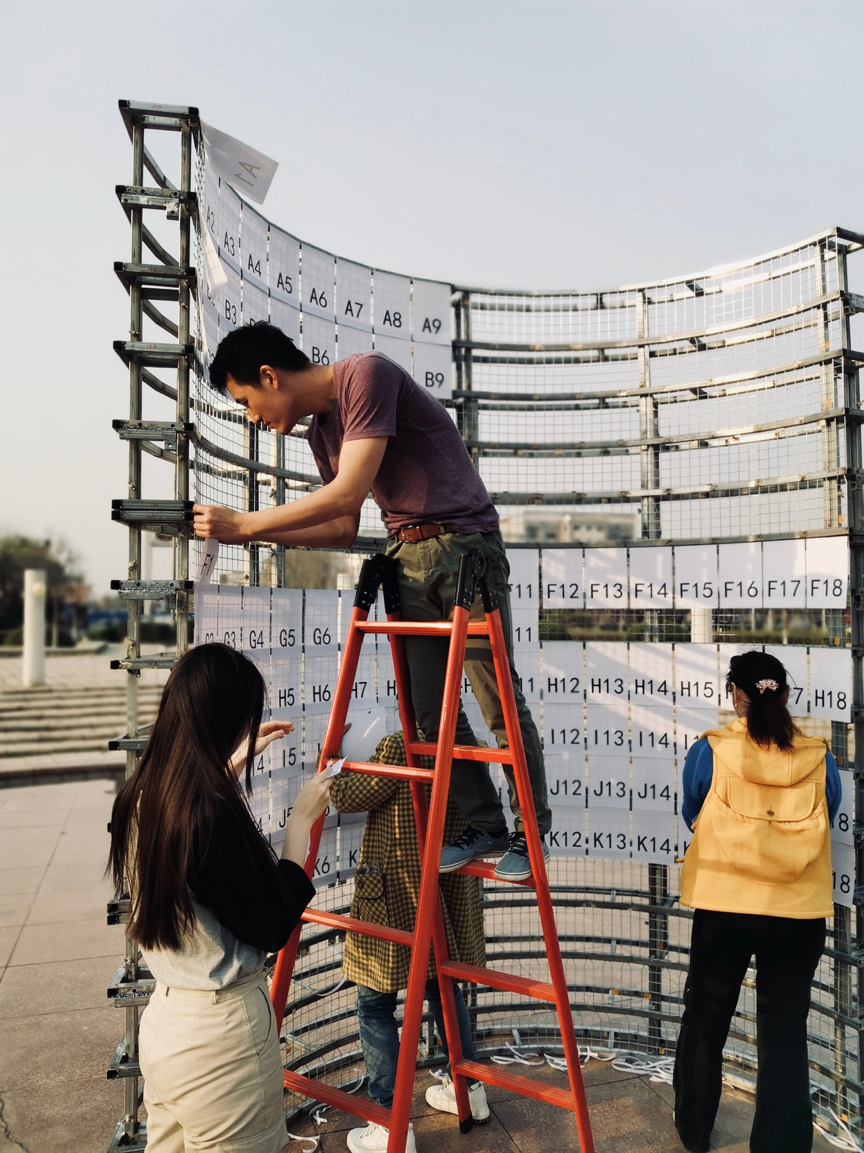
Yu Jia, Postgraduate Student of 2017 Session
Tutor: Zhang Defeng, Coordinate: Dongying, Shandong Province
Yu Jia assembled his work in the North Square of the Library for University of Petroleum in Dongying, he re-produced it after isolation. He originally planned to install it in the amphitheatre of CAFA, because only there can he naturally amplify the sound of wind blowing paper. Although the work suffered several twists and turns, but his persistence won the final victory.
This is an unprecedented creative course. If you use cultivating land as a metaphor for their creative processes, it does not start from sowing but reclaiming land. Everyone started working in their homes and rebuilt the base in this “most familiar and unfamiliar” place. Changes in the environment and situations give everyone a chance to create in introspection, which penetrates into the labor and triggers new issues and thinking.
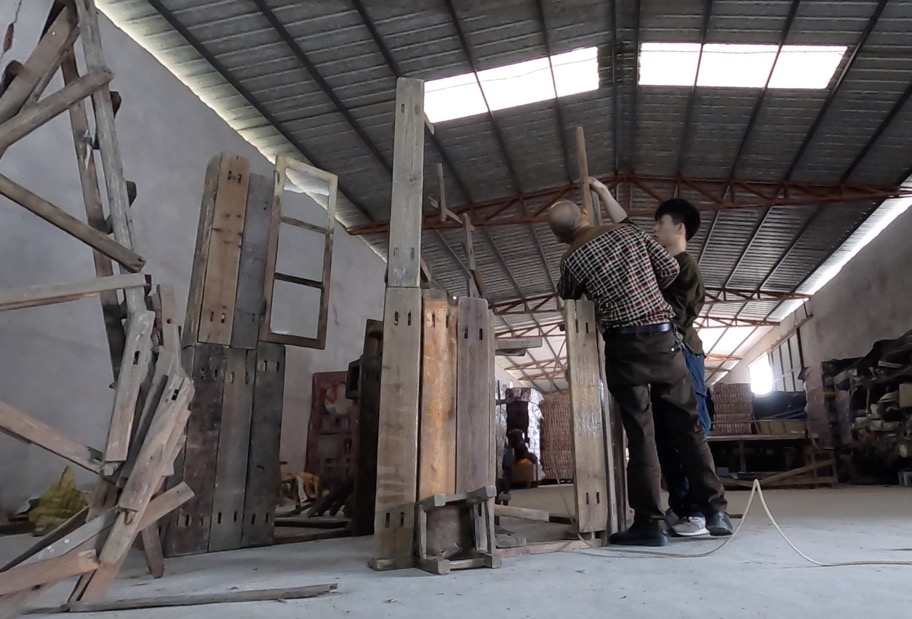 Zhang Jiayu, Undergraduate of 2015 Session,
Zhang Jiayu, Undergraduate of 2015 Session,
the First Studio of Sculpture Department, Coordinate: Jieyang, Guangdong Province
Zhang Jiayu made a scenic construction before the pandemic. Because of the limited space of studios in CAFA, the scale of his work could not be displayed. After being quarantined at home, he found a disused factory workshop near his home and rented it for a very cheap price. The old goods market in his hometown provided him with a large amount of ready-made materials, so for him, he expanded the scale of creation. The setting of the work was more magnificent than in the studio at CAFA.
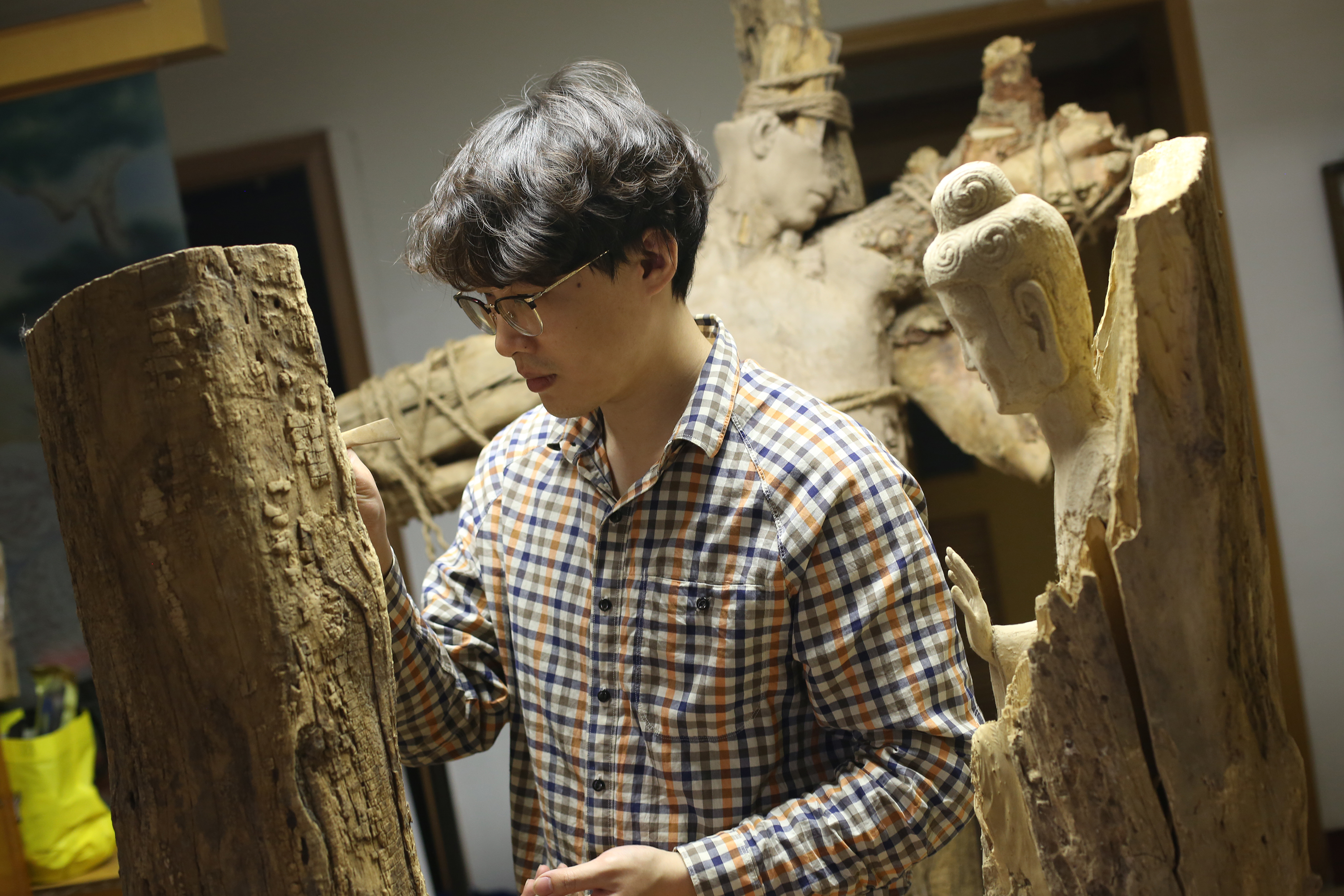
Lin Zihao, Postgraduate Student of 2017 Session
Tutor: Shen Hongbiao, Coordinate: Yanjiao, Hebei Province
Lin Zihao was creating in the living room of a rented house. His method was very traditional, a bit like the molding in a grotto. I think isolation has made him quieter, which was also a rhythm required in the work. In this online exhibition, he can only display photos, because he did not have a good camera though in the end he asked a wedding photographer to help.
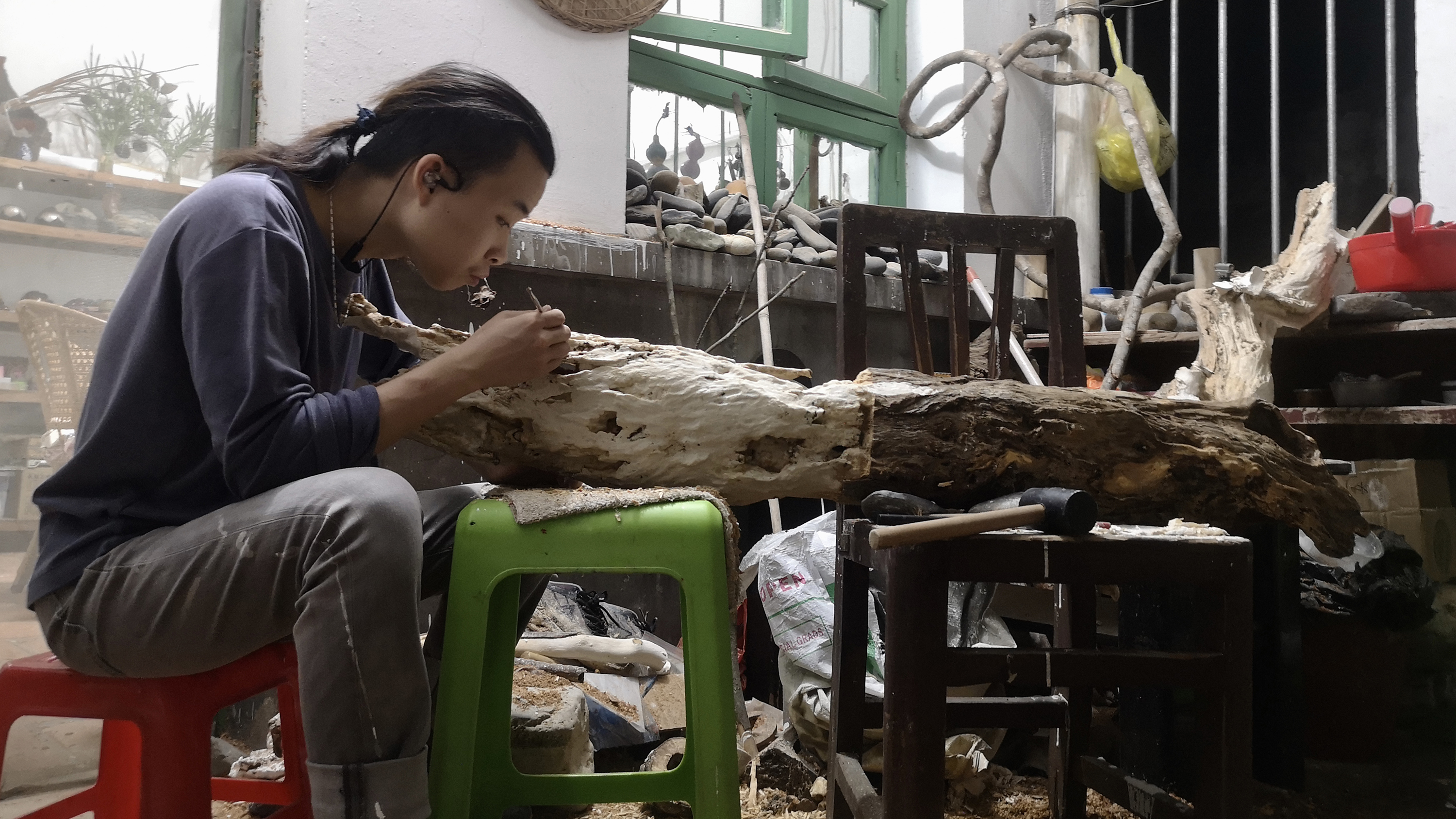
Lian Wuchu, Postgraduate Student of 2017 Session
Tutor: Lyu Pinchang, Coordinate: Longyan, Fujian Province
Lian Wuchu’s home is near the mountains. He took the dead wood from the forest and poured gypsum into it, stripping out the invisible spatial form in a solid form, so that the natural state and the unnatural state of the natural objects fit together and finally these “sculptures” were put back in the forest. He raised a question around nature and man-made: can human artistic behavior also return to being part of nature?
Sculptors now have many “identities”: laborers, adventurers and practitioners. Before the isolation, the students felt that they were sculptors. During the isolation, these three identities became true. That’s fine, don’t forget their original intention!
 Wang Chao, Postgraduate Student of 2017 Session
Wang Chao, Postgraduate Student of 2017 Session
Tutor: Duan Haikang, Coordinate: Handan, Hebei Province
Wang Chao was “opening up a big wasteland” in the stone workshop. Such good working conditions were impossible in CAFA. It’s unbelievable that he could find this place. However, his physical sculpture had no opportunity to exhibit, just photos...
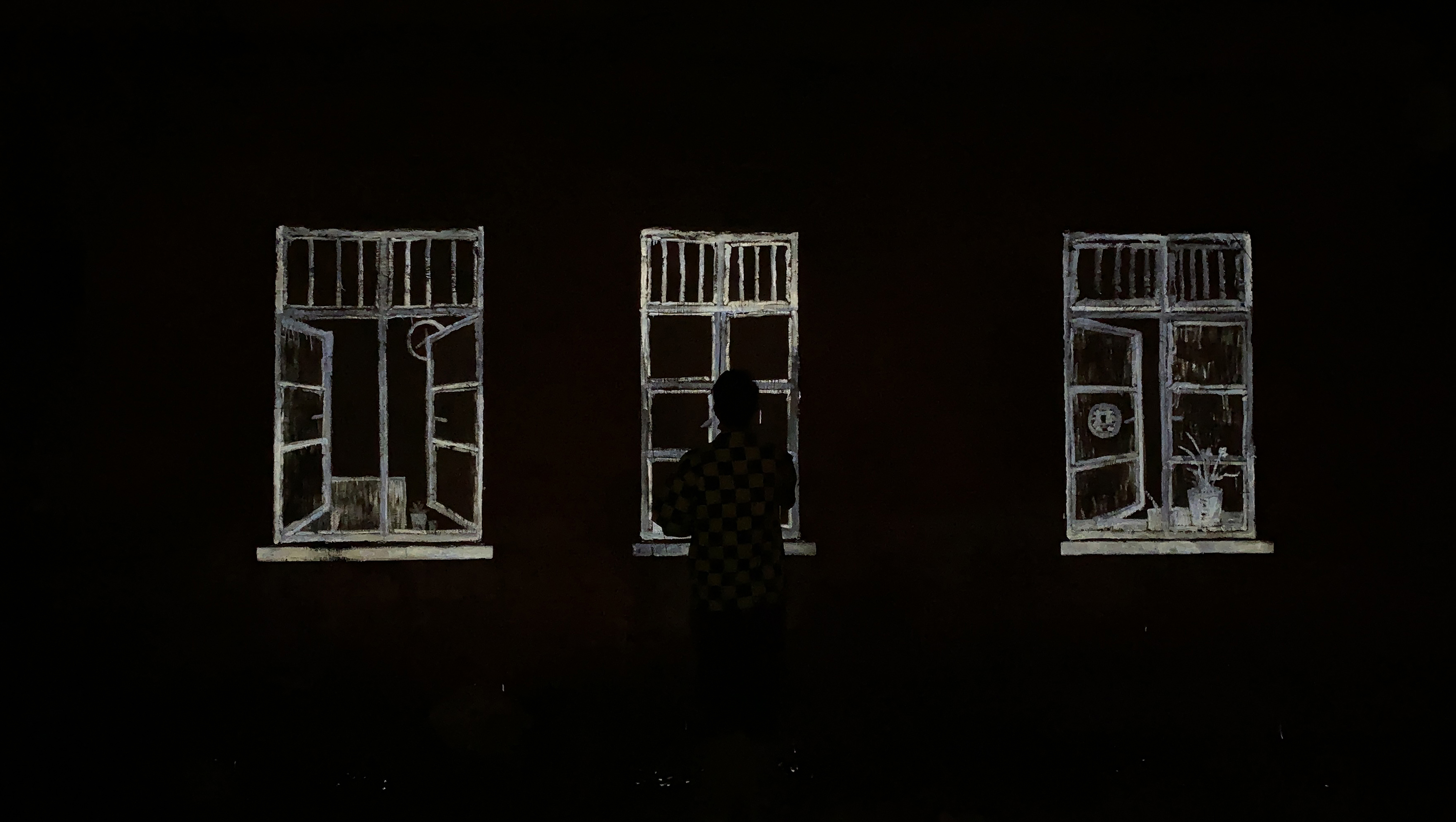
Zhang Yiran, Undergraduate of 2015 Session,
the Fifth Studio of the Sculpture Department, Coordinate: Bengbu, Anhui Province
He said: “Due to the pandemic situation, the original plan could not be carried out. It happened that the demolition area of the village in the city near my home was also stopped due to the pandemic situation. As my undergraduate study has been conducted in the Fifth Studio in the Public Art Direction of the Sculpture Department and the plan was changed to temporary creation in a public space. The entire creation revolves around ‘traces,’ using degradable temporary reflective materials to discuss everything and nothing, absence and existence.”
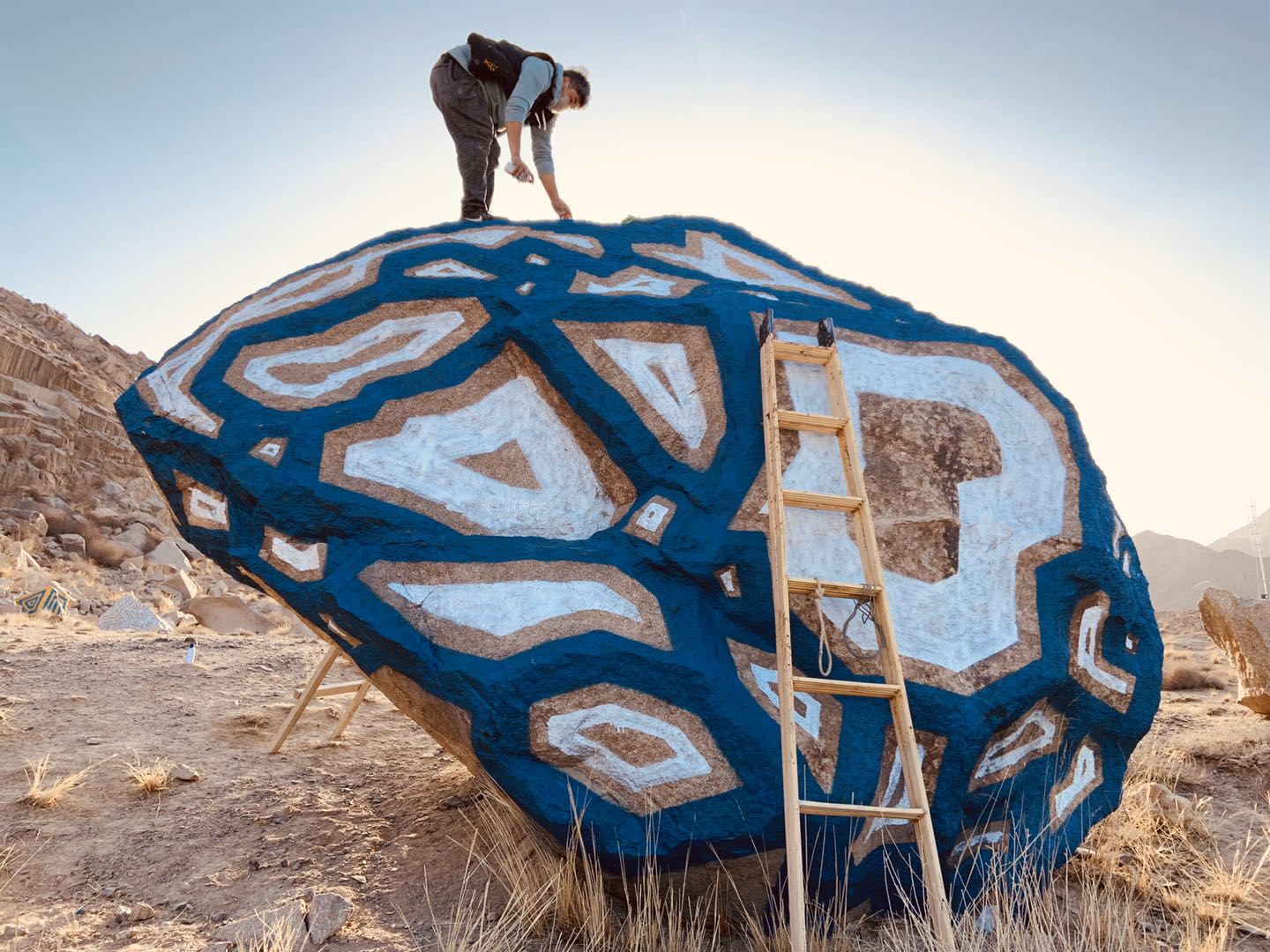
Kuder, Postgraduate Student of 2017 Session
Tutor: Shen Hongbiao, Coordinate: Urumqi, Xinjiang
Kuder has been working in the open air, following the stones to paint colors, the entire world was his work, and his exhibition venue was the largest.
For the first time this year, I was responsible for the installation of postgraduate thesis presentations. It was also the first time I had to deal with online exhibitions. I was a novice. Although I was not in charge of directing the Graduate Creation Course, I also had a deeper understanding of student creations in the organization of this exhibition. Postgraduate students are disadvantaged in their graduation creations. It is really not easy to complete their works one month in advance under the same difficulties as undergraduates. Students can finally overcome and solve difficult problems, which benefits from the accumulation of the usual creations. The normalization of the creation course made postgraduate students more comfortable with this sudden change in the environment. At the moment everyone needs wisdom and determination, which is a baptism of the growth process for young people. In the curatorial work, I learned about the creative process of the classmates and the real state of everyone. The changes of everyone were very interesting. To make a rather inappropriate description: In the past when everyone was gathering, they might “compete with each other” but now when they cannot see each other, they showed hidden talent.
CAFA ART INFO: Many changes have taken place in the graduate creation guidance of teachers under the pandemic situation. Can you talk to us about these changes and challenges you have come across?
Mu Boyan: After all, there is a great distance between the sculpture and the image. The basic elements of a sculpture, such as the shape and scale of the three-dimensional space, the sense of volume and quantity and the expressiveness of the material, must be reflected on the scene. Our online teaching guidance can only stay on the judgment of copywriting and images, but this screen has become a barrier. Teachers can only use it to create the imagination of student works, which is a bit like online shopping. When one day we see the works of students, we will find that there is a particularly big misjudgment, because the touching part of the work cannot be truly reflected by the shooting. This “presence” and “narration” are difficult to coincide.
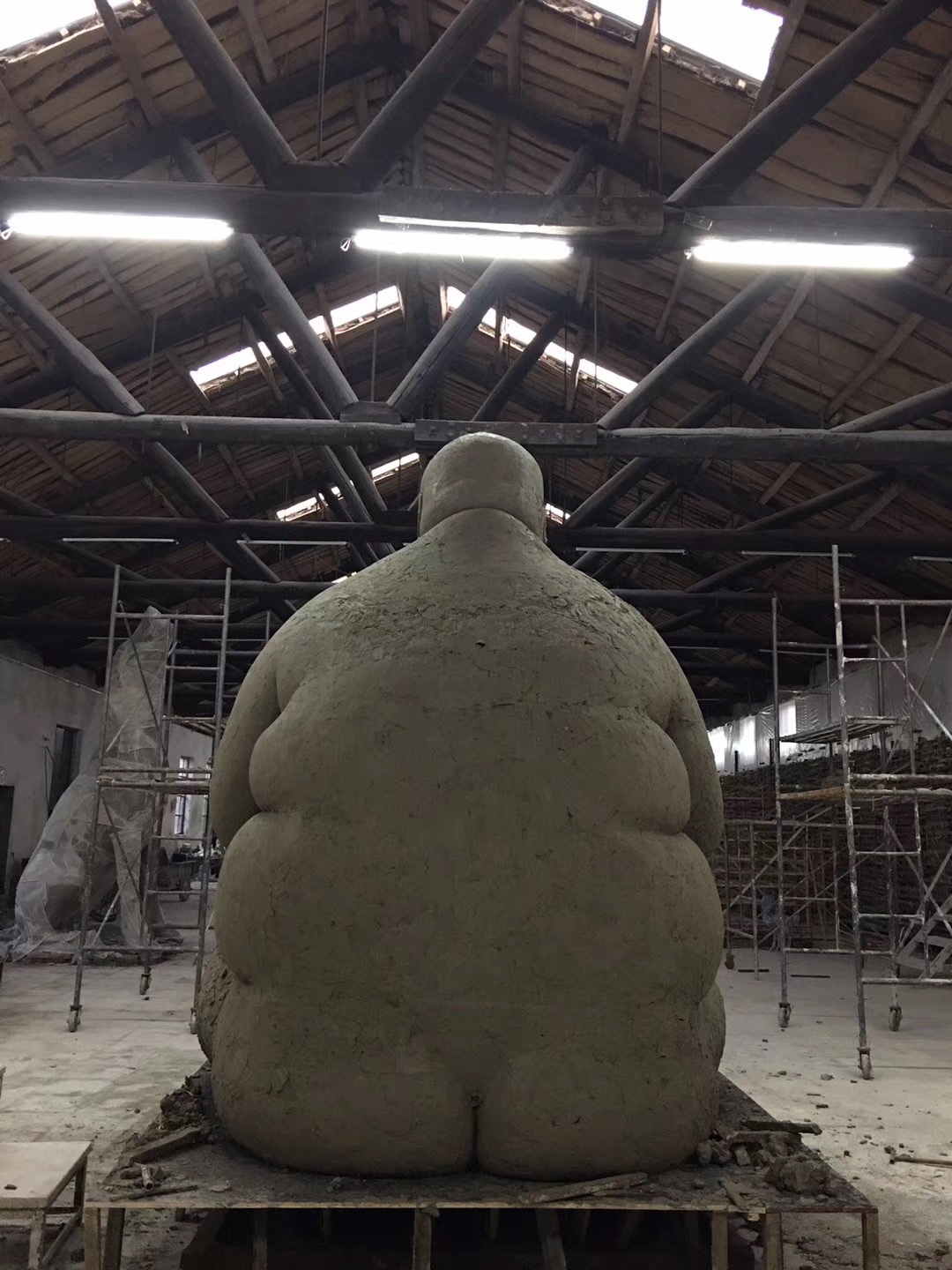 In September 2017, my work “Horizon” was in production. Making large-scale sculptures is still very enjoyable!
In September 2017, my work “Horizon” was in production. Making large-scale sculptures is still very enjoyable!
From another perspective, we may also be constrained by our own “professionalism.” Online teaching provides a window where creative teaching can come out of the conventional system, turning obstacles into turning points. The curriculum will increase the content of many project ideas and case studies according to the convenience of online teaching, and the teaching methods of the creative course will use this to increase the training suitable for thinking and the expansion of knowledge. Simply speaking, the sculptor can change his mind and do something else, which may be more helpful to the discipline.
CAFA ART INFO: From the status of students’ graduation creations we can see the impact of the pandemic on them. In the face of the new form of graduation exhibition, how has the creations of students been affected?
Mu Boyan: Simply put, everyone has just solved the “issue of creating” and then the “issue of exhibiting” emerges.
The students are faced with a perfect online display space and the works at hand are random and temporary, the effect is limited and many feelings cannot be perfectly expressed. Therefore, in order to adapt to the display effect of the online exhibition galleries, many students need to spend a lot of time and energy in improving the rendering effect of the works. Personally, I think that this will restrict some of the natural beauty and real things they have in the special period of creation. Moreover, because the conditions restrict many students from being able to scan their works, they can only display them in the form of pictures in the online exhibition galleries, so that the expressive strength of the sculpture itself is dispelled and only the transfer of an image is left.
The graduation creations of the Sculpture Department are free and open, so that the students have a great exploration in language forms. Some students present dynamic sculptures containing mechanical devices, but in the online exhibition gallery, it cannot be reflected; some students’ works need to interact with the audience on the scene, even the participation of the audience is also included in the work. Such works are even more impossible to achieve in the online exhibition gallery, so I think this graduation creation and exhibition are completely different things. Online exhibitions have put forward many new technical problems for students. In order to “place these works correctly” in the exhibition gallery, they still have to do a lot of digital processing. Many students are not proficient in this aspect. They have to deal with the reprocessing of the virtual display after finishing the physical works. The technical team of this graduation season, NetDragon Network conducts technology docking and model testing. This part of the work is quite brain-burning. But in any case, the exhibition should be done, because the works have to be released and the students are looking for outlets and solutions in the puzzle, which also stimulates great potential. In the future, more people will need to master the technology of digital modeling, which will be used as a convenient tool in the teaching activities of sculpture, and will be popularized just like driving.
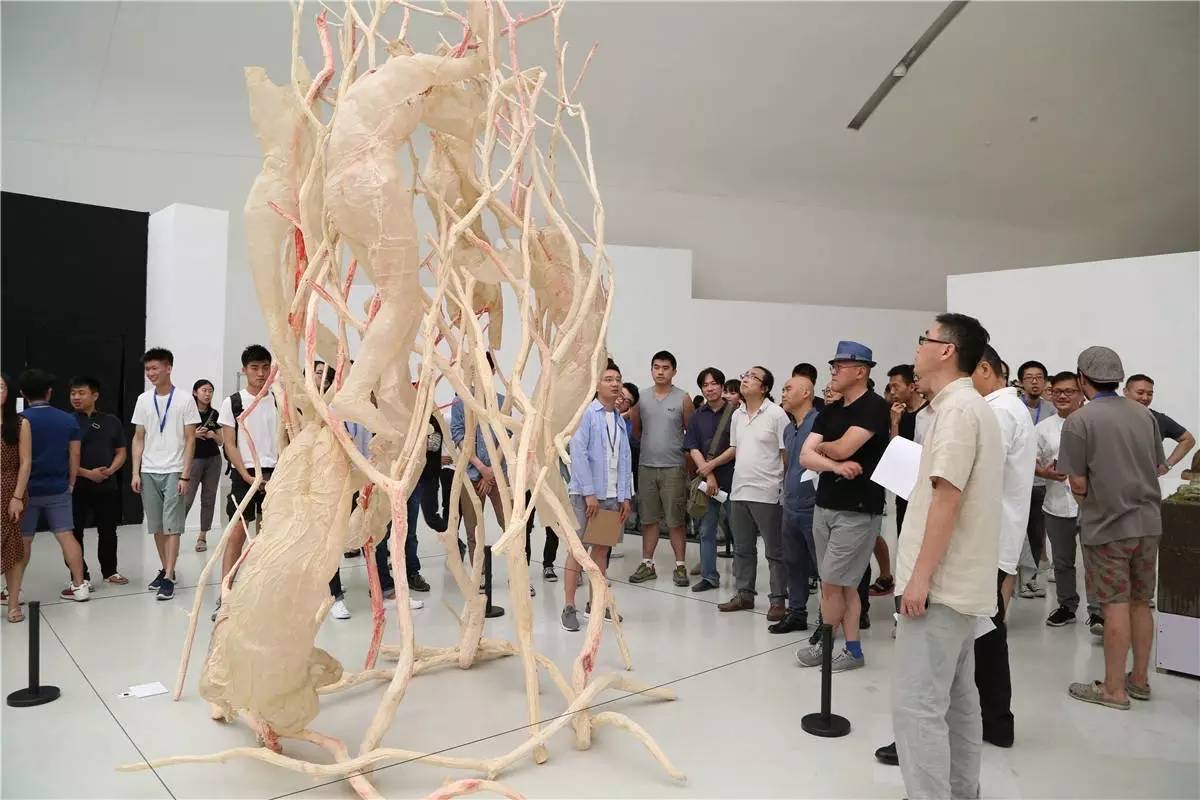
In the exhibition of the Sculpture Department of Graduation Season in 2016, Sun Guocheng stood in front of his work and explained his creative ideas to the teachers. “Big production” like this is not new over the years.
In the past decade, the Graduation Exhibition of CAFA seems to have gradually formed a “graduation exhibition phenomenon.” The graduation creations in the minds of students is far from being as simple as the answer to the end of their study, but it is regarded as a sacred thing. Also for the museum that is ultimately regarded as a container of works, it is regarded as a more sacred place, not only as an important space for examining the achievements, but also being a new starting point for their art career to the future. This sense of anticipation for the “annual event” and the sense of accomplishment that will eventually be exhibited, might become a potential motivator. Many graduates have also emerged in the graduation exhibition from here to take the first step towards society. Perhaps this kind of attention also stimulated the “strength” of each student’s creation.
The activity of the graduation exhibition is actually based on the close relationship among the artist, the work, the museum and the audience. The artist must take the space of the museum and the display effect into consideration in the form of creation. To prejudge the display effect, this undoubtedly puts relatively high requirements on one’s own work. The current special period undoubtedly broke this relationship. The on-site atmosphere of the museum no longer exists. The “production chain” that has remained unchanged for many years has been broken. If there is no pandemic intervention, the production routine of work will continue to run. Such an exhibition mode will be carried out step by step. Can you notice that this “creation for exhibition” coincides with each other?
Recalling that I walked around the room following the lens of my classmates on the screen to introduce my work and working status; or I saw someone showing his creative progress in the processing plant and I could not hear what he was talking about; or some classmate showed us works in the wild, while saying a few words on the mobile phone and it run out of electricity, he had to go down the mountain to get the electricity in the car and then continued to talk ... at this stage their labors were very simple, very essential which seems to be a naive return. So I think that if you put aside the conservative exhibition method of the virtual exhibition gallery, “ an individual’s graduation exhibition" is the most vivid portrayal of this year’s graduates, the small living room is his art museum and the wilderness is his exhibition venue, himself is the curator.

This is the virtual exhibition gallery of the Postgraduate Graduation Exhibition in the experiment. It seems awkward as there is no audience. I am looking forward to the leap of technology that can bring the audience in, just like in the game, everyone can make an appointment to watch the exhibition, let us also have an avatar in the virtual world.
CAFA ART INFO: We know that the three-dimensional aspect of a sculpture creation is relatively strong. From this perspective, will the effect of presenting sculptures in the form of online exhibitions be greatly reduced?
Mu Boyan: This situation is inevitable. Sculpture is not just a three-dimensional concept, it is difficult for virtual language to convey the energy emitted by the sculpture itself. Scale, materials, scene, time, touch, etc. are all expressions of their languages, and face-to-face viewing is extremely important. The online exhibition only provides the audience with the complete information in viewing and experience. If all the languages in the sculpture have to be translated in a virtual way, the power of the work in the virtual exhibition gallery will be weakened. For example, those shaping objects in figurative works are gone and only a shell is left after being made virtual; the touching thing about material creation is the material itself, now everyone has to “render” the material in the 3D model, then it is a fake and cold thing; some works have sound, light and electric effects and the technical requirements cannot be met in the virtual exhibition gallery. This kind of work suffers the most. In short, the function of the online exhibition gallery is more suitable as a means to record. It is documentary and not purely suitable for display.
CAFA ART INFO: This year, CAFA Graduation Exhibition launched the “online” virtual museum galleries for the first time. What do you think of the future development of this new form of graduation exhibition?
Mu Boyan: Here it just occurred to me that I saw news of the game world recently. The advent of Unreal Engine 5 has brought a leap in virtual technology. Nanite virtual micro-polygonal geometry can allow artists to create all the geometry details that the human eye can see and the pictures are very shocking. I want to say that the virtual world has its unique charm. If “virtual” is used as a language in art exhibitions, the thinking of artistic creation should also reach a new dimension. With the development of technology, I think that in the future, the virtual exhibition will become an independent spatial language form parallel to the physical exhibition. By that time, a virtual exhibition hall in the true sense is far from imitating a three-dimensional space, nor is it a simple thing to place sculptures and paintings in it, but a more multi-dimensional, more exciting and infinitely imaginative space.
“Online CAFA” is just a small beginning. It is conceivable that in the future graduation exhibition, there will be a virtual art museum at the same time as the physical exhibition. This art museum can change the form every year, you can choose any place, create any idea, or you can do a graduation season on Mars, because it is omnipotent in the virtual. There are more than exhibitions, some of our related discipline directions will also focus on it. Some students will be engaged in the creation of virtual art, and more amazing works will appear in the future.
 As a virtual world, Unreal Engine 5 can make the virtual scene impeccable and the virtual language is inestimable.
As a virtual world, Unreal Engine 5 can make the virtual scene impeccable and the virtual language is inestimable.
CAFA ART INFO: Earlier we talked about some topics on students. Now please talk about your status during this period.
Mu Boyan: During this period, I can only focus on the teaching work, so that students can graduate well, and have as little regret as possible. I really want to go back to the creative state and make sculptures.
CAFA ART INFO: Do you remember your graduation exhibition? From then to now, please talk to us about your feelings.
Mu Boyan: The year of my graduation exhibition was 2005. At that time, it was exhibited in the Multi-functional Hall of CAFA. It was basically a reporting display, not an exhibition. At that time, there was not a good space such as CAFA Art Museum for exhibitions and there was not such enthusiastic spectators. The memory seemed to be a gray and cold feeling. At that time, our works did not consider the effects of the exhibition hall at all. Whatever we wanted to do, what we showed, there was no decent exhibition venue. The current exhibition hall is very high-end, with a strong academic atmosphere and countless eyes watching you. The students will be eaten up by the museum if they don’t do well and so every year, everyone “crawls so high that they can't get off.”
 In the Graduation Season of June 2017, I took a picture of Mr. Sun Jiabo holding flowers. Everyone was very happy that day. Teachers actually care more about graduation exhibitions than students.
In the Graduation Season of June 2017, I took a picture of Mr. Sun Jiabo holding flowers. Everyone was very happy that day. Teachers actually care more about graduation exhibitions than students.
CAFA ART INFO: Finally, please send your kind wishes to the graduating students.
Mu Boyan: No effort, no gain, this sentence works at any time.

Artist Mu Boyan
About Mu Boyan
He is currently Associate Professor in the Sculpture Department of the Central Academy of Fine Arts.
Born in Jinan, Shandong Province in 1976.
In 1997 he graduated from the High School Affiliated to the Central Academy of Fine Arts;
In 2002 he graduated from the Sculpture Department of Central Academy of Fine Arts with a Bachelor’s Degree;
In 2005, he graduated from the Sculpture Department of Central Academy of Fine Arts with a Master’s Degree and has stayed to teach at the Sculpture Department.




























